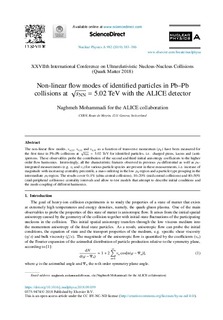Non-linear flow modes of identified particles in Pb–Pb collisions at √sNN=5.02TeV with the ALICE detector
Mohammadi, Naghmeh; Acharya, Shreyasi; Acosta, Fernando T.; Adamová, Dagmar; Adolfsson, Jonatan; Aggarwal, Madan M.; Aglieri Rinella, Gianluca; Agnello, Michelangelo; Agrawal, Neelima; Ahammed, Zubayer; Alme, Johan; Altenkaemper, Lucas; Djuvsland, Øystein; Ersdal, Magnus Rentsch; Fionda, Fiorella Maria Celeste; Nystrand, Joakim; Rehman, Attiq Ur; Røhrich, Dieter; Tambave, Ganesh Jagannath; Ullaland, Kjetil; Wagner, Boris; Zhou, Zhuo; Arsene, Ionut Cristian; Bätzing, Paul Christoph; Dordic, Olja; Lardeux, Antoine Xavier; Lindal, Svein; Mahmood, Sohail Musa; Malik, Qasim Waheed; Richter, Matthias; Røed, Ketil; Skaali, Toralf Bernhard; Tveter, Trine Spedstad; Wikne, Jon Christopher; Zhao, Chengxin; Hetland, Kristin Fanebust; Kileng, Bjarte; Nesbø, Simon Voigt; Storetvedt, Maksim Melnik; Helstrup, Håvard; Langøy, Rune; Lien, Jørgen; Ahn, Sang Un; Aiola, Salvatore; Akindinov, Alexander; Al-Turany, Mohammad; Alam, Sk Noor; Albuquerque, D. S. D.; Aleksandrov, Dmitry; Alessandro, Bruno; ALICE, Collaboration
Journal article, Peer reviewed
Published version
Permanent lenke
http://hdl.handle.net/11250/2640201Utgivelsesdato
2019Metadata
Vis full innførselSamlinger
- Institutt for mikrosystemer [546]
- Publikasjoner fra CRIStin [3623]
Sammendrag
The non-linear flow modes, v4,22, v5,32 and v6,33 as a function of transverse momentum (pT) have been measured for the first time in Pb–Pb collisions at for identified particles, i.e. charged pions, kaons and (anti-)protons. These observables probe the contribution of the second and third initial anisotropy coefficients to the higher order flow harmonics. Interestingly, all the characteristic features observed in previous pT-differential as well as pT-integrated measurements (e.g. v2 and v3) for various particle species are present in these measurements, i.e. increase of magnitude with increasing centrality percentile, a mass ordering in the low pT region and a particle type grouping in the intermediate pT region. The results cover 0–1% (ultra-central collisions), 10–20% (mid-central collisions) and 40–50% (mid-peripheral collisions) centrality intervals and allow to test models that attempt to describe initial conditions and the mode-coupling of different harmonics.
Beskrivelse
Published by Elsevier B.V. This is an open access article under the CC BY-NC-ND license

